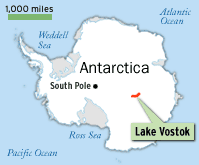Lake Vostok
Lake Vostok is an underground Antarctic lake near to the Russian Vostok Station, discovered in 1977 during an airborne radio-echo survey of ice depths over central East Antarctica. In 1993, altimetry measurements from the ERS-1 satellite verified the lake's existence and extent, confirming it to be by far the largest deep sub-ice body of water on the planet. In 1996, Russian and British scientists combined radio sounding, altimetric, and seismic data to provide the most comprehensive picture of the lake currently available.1
 |
Lake Vostok extends over about 14,000 square meters(roughly the size of Lake Ontario) and is overlaid by 3,710 meters (12,170 feet) of ice. It has a maximum depth of 510 meters, an average depth of 125 meters, a volume of 1800 cubic kilometers, and a bed that is 710 meters below sea level. It may be 500,000 to 1 million years old and, based on density measurements, is composed of fresh water.
Researchers hope that, aside from its intrinsic interest, Lake Vostok will serve as a natural terrestrial laboratory to help understand the conditions that may exist in the putative subsurface oceans on Jupiter's moons Europa and Callisto. In particular, NASA has identified four objectives in its Europa Vostok Initiative. These are to investigate the nature and origin of the lake, obtain evidence of long-term climatic change associated with it, identify a site suitable for in-situ microbiological exploration, and validate the design of planetary radar sounders for exploration of Europa. A first step toward developing instrumentation for exploring Lake Vostok was taken in 1998 with the deployment of the Lo'ihi Underwater Volcanic Vent Mission Probe.
Of primary concern is that any vehicle and instrumentation introduced into Lake Vostok be scrupulously clean of biological material to avoid contaminating any indigenous life (see forward-contamination). Among the instruments and measurement methods that may be used on the first entry probe into the lake are redox sensors and UV Raman and fluorescence spectroscopy.
At the time of writing, the lake remains unpenetrated although 400,000-year-old deep ice samples have been obtained from just 100 meters above its liquid surface. Within these samples, Richard Hoover of NASA's Marshall Space Sciences Lab. and S. S. Abyzov of the Russian Academy of Sciences found a variety of microbial life-forms, some of them readily recognizable (including cyanobacteria, bacteria, fungi, spores, pollen grains, and diatoms) but others unlike anything ever seen before.2
Another sub-ice lake in Antarctica of great interest to astrobiologists is Lake Vida.
References
1. Kapitza, A. P., Ridley, J. K., Robin, G. de Q., Sigert, M. J., and
Zotikov, I. A. "A Large, Deep Freshwater Lake Beneath the Ice of Central
East Antarctica," Nature, 381 (1996).
2. Stone, R. "Russian Outpost Readies for Otherwordly Quest," Science, 279, 650 (1998).


